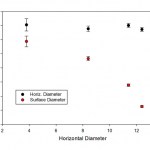Science
A couple of times last week, I mentioned on Twitter that I was going to demonstrate relativity with toddler toys and string. This was an inspiration that hit late on Thursday, when I was trying to think of a better way to explain embedding diagrams (the technical term for those stretched-rubber-sheet pictures that everybody uses to illustrate general relativity).
Specifically, I was hearing a lot from students who didn't understand the point of what was supposed to be weird about those. So I was trying to think of how to do a demo, when I realized we could measure the change in geometry that…
Medical conspiracy theories tend to involve “someone” hiding something from the public. I like to refer to this as the fallacy of “secret knowledge.” That “someone” hiding the “secret knowledge” is usually the government, big pharma, or other ill-defined nefarious forces. The “secret knowledge” being hidden comes invariably in one of two flavors. Either “they” are hiding cures for all sorts of diseases that conventional medicine can’t cure, or “they” are hiding evidence of harm due to something in medicine. Although examples of the former are common, such as the “hidden cure for cancer,” it…
I'm teaching a Gen Ed course on relativity this term, which means I'm spending the last few weeks of the term discussing black holes. Which, in turn, means there was no way I couldn't use that story about Kip Thorne calculating the appearance of a black hole for the movie. Especially since I have the students reading Thorne's book.
And that, in turn, meant I needed to see the movie. So we got a sitter for the kids Saturday night, and went to the local theater to check it out. And, you know, it's pretty much what it's advertised as: A very pretty giant SF movie, with all that implies, both…
Gayle DeLong has been diagnosed with what she refers to as “autism-induced” breast cancer.” She’s even given it an abbreviation, AIBC. Unfortunately, as you might be able to tell by the name she’s given her breast cancer, she is also showing signs of falling into the same errors in thinking with respect to her breast cancer as she clearly has with respect to autism. As a breast cancer surgeon, regardless of my personal opinion of DeLong’s anti-vaccine beliefs, I can only hope that she comes to her senses and undergoes science-based treatment, but I fear she will not, as you will see. Her…
I'm teaching relativity in a course with an astronomy prefix, which means I'm obliged to talk about stars and stuff. Yesterday's lecture was about neutron stars, and how their existence was confirmed by the discovery of pulsars (with the story of Jocelyn Bell Burnell included). This requires some discussion of angular momentum to explain how something that big ends up spinning that fast (cribbing a bit from these online notes), so I needed a good demonstration of angular momentum. Which is when I remembered this 2013 post with SteelyKid on the playground, where I estimated the mass of the…
Two months ago, one of the strangest stories ever to be flogged by antivaccine activists was insinuating its way throughout social media, including Twitter, Facebook, and everywhere else, where antivaccine activists were engaged in a frantic effort to get the attention of mainstream media regarding their belief that there was a "CDC whistleblower" who had revealed a "cover up" that results from a CDC study looking at age of receiving MMR vaccination was studied as a potential risk factor for autism had shown that African-American boys showed a more than three-fold increased risk due to MMR…
Blogging will continue to be light to nonexistent, as it's crunch time in a lot of ways at the moment, including our double tenure-track search. Which it would be inappropriate to talk about in any more detail than "Wow, this is a lot of work."
There are, however, two academic-job-related things that I probably ought to mention briefly. One is this Inside Higher Ed Essay about metaphors for the academic hiring process, which rightly points out a lot of the problems with the "lottery" analogy that lots of people like to use. In fact, Gerry Canavan argues, it's best understood as a game:
But…
One thing that happened this week that I didn’t get around to writing about is the 100th anniversary of the birth of Jonas Salk, which was October 28. In the annals of medicine, few people have had as immediate a positive effect as Jonas Salk did when he developed the inactivated polio vaccine (IPV). At the time the IPV became available in 1955, annual epidemics of polio were a regular feature of American life, causing panics and closing public swimming pools with a distressing frequency, causing thousands of cases of paralysis per year and many deaths. Indeed, in 1952 one particularly bad…
R.I.P., McKenzie Lowe. Unfortunately, Stanislaw Burzynski was no more able to save you than anyone else, his claims of great success treating pediatric brain tumors notwithstanding:
HUDSON — Thirteen-year-old Hudson resident McKenzie Lowe died Friday evening after a 2-year-battle against an aggressive and inoperable brain stem tumor.
McKenzie died at 10:27 p.m. in her own bed at her home in Hudson.
McKenzie was diagnosed on Nov. 28, 2012 with Diffuse Intrinsic Pontine Glioma, or DIPG, a brain tumor located on the brain stem. Patients with DIPG typically survive for less than a year.…
A fine if somewhat intermittent tradition hereabouts has been the offering of high-concept Halloween costumes for people interested in physics, surfacing in 2010, 2012, and 2013. I'm a little too fried right now to do anything all that deep, but I'll try to offer a few suggestions; see also these particle-physics suggestions from Symmetry magazine, who have an art staff to make animated GIFs of their ideas.
Sexy Tycho Brahe: Ruffled collar, magnificent mustache, a little gold paint on your nose. Critically important that you remember to go to the bathroom beforehand, though-- it's going to be…
If there is one thing that the ongoing Ebola outbreak in Africa has revealed to the world, it’s the full extent of quackery that is out there and advertised as being able to treat deadly diseases such as Ebola. The deadlier the disease, the more quackery is out there, amplified by the scariness of the disease. And, make no mistake about it, Ebola is scary. No, it’s not scary here in the U.S., where the odds of the average person catching the disease, particularly if he’s not a health care worker who’s directly cared for a patient with Ebola, is vanishingly tiny. If you happen to live in…
One of the biggest medical conspiracy theories for a long time has been that there exist out there all sorts of fantastic cures for cancer and other deadly diseases but you can’t have them because (1) “they” don’t want you to know about them (as I like to call it, the Kevin Trudeau approach) and/or (2) the evil jackbooted thugs of the FDA are so close-minded and blinded by science that they crush any attempt to market such drugs and, under the most charitable assessment under this myth, dramatically slow down the approval of such cures. The first version usually involves “natural” cures or…
As mentioned last week, I was the on-hand expert for the Secret Science Club's foray into Massachusetts, a screening of the movie Particle Fever held at MASS MoCA. This worked out nicely in a lot of respects-- it gave me an excuse to visit the newly renovated Clark Art Institute in Williamstown and check out the spiffy new library at Williams (where they have my second book on the shelves, but not my first; I may need to send them an author copy in lieu of a check this year...). I also did some random nostalgia things like grabbing dinner at Colonial Pizza (now in a strip mall halfway to…
It's the Bone Eating Snot Flower Worm.
As a bonus, it's also one of those species where the large adult forms are all females, and the males have been reduced to a tiny bag of sperm attached for life to a Bone Eating Snot Flower Worm.
I got the time for the regular hangout wrong, and then we had some weird computer difficulties, so we only had ten minutes for Uncertain Dots this week. Which was enough time for me to say disparaging things about comic book movies, so, you know, if that interests you...
Here's the making of Interstellar story about Kip Thorne.
Here's the Avengers 2 trailer.
Also, a program note: I will be at MASS MoCA tonight talking about Particle Fever, if you'd like to hear me talk about real physics on film, or just take issue with my slagging off comic-book movies in person...
The Discovery Institute doesn't understand the protein folding problem. I mean that literally: they don't understand the problem. Scientists don't know the answer, but they have a clear understanding of the problem.
PNAS published a "Perspective" article, "The Nature of Protein Folding Pathways," by S. Walter Englander and Leland Mayne. Unsurprisingly, they try to approach the problem from purely materialistic presuppositions. There is no mention of specificity, amino acid sequence, or digital information.
You see, there really is an interesting problem here: given a specific amino acid…
The image below is a phylogram, illustrating the degree of variation in a sequence of mitochondrial DNA. The concept is fairly simple: if two DNA samples are from individuals that are evolutionarily distant from one another, they'll have accumulated more differences in their mitochondrial DNA, and will be drawn farther apart from one another. If the two individuals are closely related, their DNA will be more similar, and they'll be drawn closer together. That's the key thing you need to know to understand what's going on.
There are other, more complicated analyses going on in the figure, too…
Over at Backreaction, Bee has a nice piece on our current age of virality. Toward the end, she discusses some of the ways this applies to science, specifically a quote from this Nature article about collaborative efforts to measure "big G", and a story about a Chinese initiative to encourage collaboration. She writes of the latter, "Essentially, it seems, they’re giving out salary increases for scientists to think the same as their colleagues."
And I agree that this can be a problem-- there's a famous paper I can never find looking at the evolution of the accepted value of some physical…
Teachers in the D.C. Metropolitan area- we are now accepting applications for the Nifty Fifty (x4) Program! Click here to apply NOW to host a speaker at your school during the 2014/2015 school year. Nifty Fifty talks will take place during the months of February, March and April of 2015.
The deadline to apply is Friday, November 21, 2014. Submit your application by following this link and select your top speaker choices. Speakers are available for middle and high schools in Washington D.C. and surrounding areas.
Some of the new speakers joining our program include:
Deborah…
I have to admit that my first response to these reports out of Britain that stem cells had been successfully used to repair a complete spinal cord transection was skepticism -- incredulity even. They're reporting that a man with a completely severed spinal cord at level T10-T11 is able to walk again! The Guardian gushes! The Daily Mail gets in the act (always a bad sign)! When I read that the patient had an 8mm gap in his spinal cord that had been filling up with scar tissue for the last two years, I was even more doubtful: under the best of conditions, it was unlikely that you'd get…





